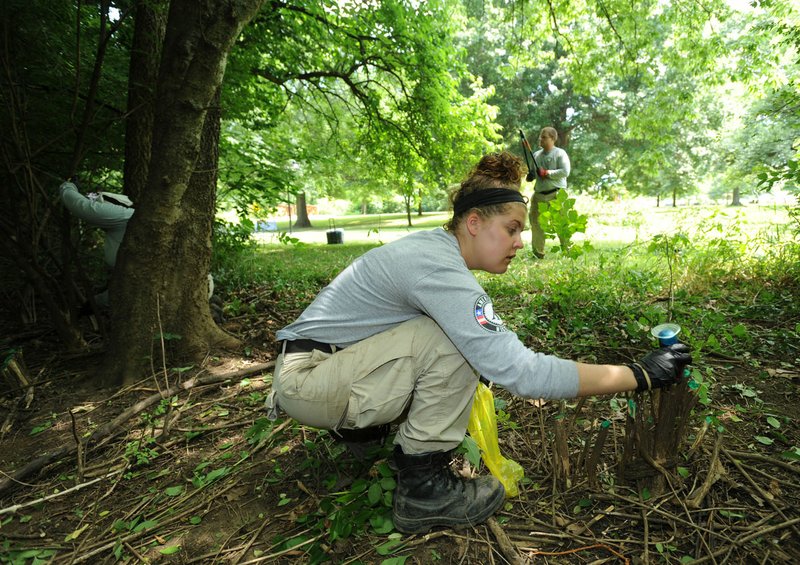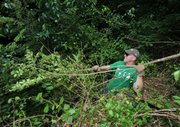Baby birds will starve without caterpillars, and caterpillars can't live on the non-native plants growing wild in Northwest Arkansas, experts said.
The plants choking off the food supply for young birds also threaten to harm the water quality of Beaver Lake, the region's supply of drinking water, said Jennifer Ogle of West Fork, a botanist for the nonprofit Beaver Watershed Alliance, which watches over the lake's watershed.
Groups that support local efforts to remove and replace invasive plants include:
http://www.beaverwa…">1.Beaver Watershed Alliance
http://www.fayettev…">2.“Invasive Plants and Native Alternatives”
http://findnativepl…">3.Find Native Plants — Arkansas
http://https://anps…">4.Arkansas Native Plant Society, Ozarks Chapter
http://ar.audubon.o…">5.Audubon Arkansas — Native plant habitat page
http://www.irwp.org/">6.Illinois River Watershed Partnership
No one has taken a comprehensive survey of just how much ground non-native plants cover throughout the region, but nothing in nature is stopping them.
Compare the situation with Northwest Arkansas and invasive plants to someone knowing he has cancer without knowing the full extent, said Donald Steinkraus, professor of entomology at the University of Arkansas.
"Cancer starts with a single cell. Then it grows unchecked. The earlier you find it and treat it, the better your chances of surviving. The later you start reacting, the harder it's going to be to treat."
Groups of volunteers are making headway, but the task is a battle.
"We need an army," he said.
Beneath the greenery
The plant that most directly threatens local water quality does so because it also threatens the soil. The bush honeysuckle was a landscaping plant popular in the 1970s because it quickly grew into a mid-level shrub with a thick cover of leaves. Those leaves also grew out early in the year into an attractive spread of green.
"Green isn't always good," said Ogle, who co-edited the Atlas of the Vascular Plants of Arkansas, released in 2013, and is a member of the board of the Arkansas Native Plant Society and the Fayetteville Natural Heritage Association.
The qualities making the bush honeysuckle an attractive decorative plant mean, in the wild, stands cover acres with a relatively low, thick, early spreading layer of leaves. Almost no plants below that layer can survive in the shade.
No trees above that layer can reproduce as their seeds fall into the gloom. The healthy-looking stand of mature trees can be one generation away from dying, Ogle said.
"Plants have to have sunlight," she said. "This plant with no predators -- you won't even find a leaf that's been nibbled on -- takes all the sunlight."
What looks like healthy hillsides covered by trees with an thriving understory covers a desert of bare soil when viewed from underneath. One thing that will break through the leaf cover is rain, which washes soil away. That soil winds up in creeks, streams and eventually lakes.
Food chain
Young birds from hummingbirds to robins, bluebirds and warblers depend on soft, nutritious caterpillars for food, Steinkraus said. Even bird species that depend on seeds and other sources as adults need caterpillars for their young.
"A single nest can require 100 caterpillars a day, maybe more," Steinkraus said. Caterpillars are "the hamburger of the forest."
Adult birds such as swallows, swifts and nighthawks along with other creatures like bats depend on the moths that caterpillars become for food, he said.
And, of course, some caterpillars become butterflies. Moths and butterflies are vital pollinators of local wild plants. Some of the region's largest and most beautiful species of butterfly are at risk, he said.
Native plants feed native caterpillars. More than 500 different species of caterpillar, for example, can graze lightly upon healthy oak trees while smaller plants host fewer varieties. None feed off a host of decorative plants that have gone wild, Steinkraus and other experts said. As these "inedible" plants spread, they create a famine with the appearance of plenty by choking off "edible" plants.
"It's not important if you really don't care about hummingbirds, bluebirds and butterflies," Steinkraus said. "If you think sheer beauty is an important part of life, and, if we want to have songbirds, this is very serious."
Some of the region's most impressive and beautiful butterflies such as the giant swallowtail are absolutely dependant on native plants that are getting pushed out, he said.
Many invasive varieties also have no food benefit for native bees, Steinkraus said, making them work harder to pollinate.
"They can roam up to three miles from the hive but need a lot of flowers along the way," he said.
Even the fruits of non-native plants that birds can eat are often high in sugar, said Peter Nierengarten, Sustainability and Resilience Department director for Fayetteville.
"Birds do like to eat it. It's like candy. Like candy, though, it lacks the protein and carbohydrates they have to have," he said. In the worst case, there are types of berries that are highly attractive -- but poisonous -- to a local bird species called the Cedar Waxwing.
Selling points
Some invasive plants are evergreen. Year-round greenery and resistance to local diseases and pests was why many of these species were brought here in the first place, Ogle said.
"They were popular because they not just survive, they look good doing it," she said.
The plants are also more drought-resistant than local species, another selling point, Nierengarten said.
The bush honeysuckle and other invasive species of plants got a big boost from the ice storm of 2009, a severe weather pummelling that stripped off the tops of a lot of tree cover, he said.
"That let a lot of sunlight get through and these plants really took off. They shaded out the local wildflowers and other species early in the springtime, and we were left with a honeysuckle mono-culture in a lot of places," he said.
The City Council recently voted to make Fayetteville the first city in Arkansas to ban the use of 18 invasive plants in large-scale developments such as commercial building projects and multifamily housing complexes.
Human intervention to remove invasive plants is labor intensive.
"You can get a few volunteers together for one afternoon and pull up a mound of these things," Steinkraus said.
Pulling them up is not enough. The seeds those invasive species leave in the ground will flourish afterward. Steinkraus and his wife own 40 acres near West Fork. Keeping invasive plants off their land has become a constant battle they're not sure of winning, he said.
"I used to be against herbicides in trying to control these species," Ogle said. "I've changed my mind. You don't want to use more than you have to, but once volunteers have cut some of these plants down, you have to apply something to the stem to keep it from coming back.
"What's encouraging is that we've never encountered anyone who didn't care once they learned about the scope of the problem," she said.
Volunteer groups around the region are helping, and local nurseries and lawn supply companies are at the forefront of encouraging landowners to use native varieties, she said. Landscapers are very aware of the issue, she said.
"We're talking about the integrity of our watershed and whether a lot of local species of plants and animals survive. Even birds that find caterpillars for themselves or their nest are having to fly across a wider and wider range to gather them. They're using up energy," Ogle said.
NW News on 07/05/2016

